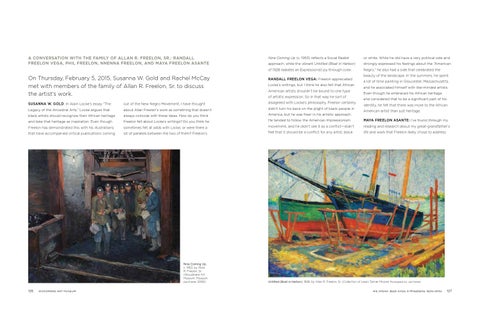A CONVERSATION WITH THE FAMILY OF ALLAN R. FREELON, SR.: RANDALL FREELON VEGA, PHIL FREELON, NNENNA FREELON, AND MAYA FREELON ASANTE
On Thursday, February 5, 2015, Susanna W. Gold and Rachel McCay met with members of the family of Allan R. Freelon, Sr. to discuss the artist’s work.
Nine Coming Up (c. 1953) reflects a Social Realist
or white. While he did have a very political side and
approach, while the vibrant Untitled (Boat in Harbor)
strongly expressed his feelings about the “American
of 1928 radiates an Expressionist joy through color.
Negro,” he also had a side that celebrated the
RANDALL FREELON VEGA: Freelon appreciated
Locke’s writings, but I think he also felt that African American artists shouldn’t be bound to one type of artistic expression. So in that way he sort of
beauty of the landscape. In the summers, he spent a lot of time painting in Gloucester, Massachusetts, and he associated himself with like-minded artists. Even though he embraced his African heritage and considered that to be a significant part of his
SUSANNA W. GOLD : In Alain Locke’s essay “The
out of the New Negro Movement, I have thought
disagreed with Locke’s philosophy. Freelon certainly
Legacy of the Ancestral Arts,” Locke argues that
about Allan Freelon’s work as something that doesn’t
didn’t turn his back on the plight of black people in
black artists should recognize their African heritage
always coincide with these ideas. How do you think
America, but he was freer in his artistic approach.
and take that heritage as inspiration. Even though
Freelon felt about Locke’s writings? Do you think he
He tended to follow the American Impressionism
MAYA FREELON ASANTE: I’ve found through my
Freelon has demonstrated this with his illustrations
sometimes felt at odds with Locke, or were there a
movement, and he didn’t see it as a conflict—didn’t
reading and research about my great-grandfather’s
lot of parallels between the two of them? Freelon’s
feel that it should be a conflict for any artist, black
life and work that Freelon likely chose to address
that have accompanied critical publications coming
Nine Coming Up, c. 1953, by Allan R. Freelon, Sr. (Woodmere Art Museum: Museum purchase, 2006)
126
WOODMERE ART MUSEUM
identity, he felt that there was more to the African American artist than just heritage.
Untitled (Boat in Harbor), 1928, by Allan R. Freelon, Sr. (Collection of Lewis Tanner Moore) Photograph by Joe Painter WE SPEAK: Black Artists in Philadelphia, 1920s–1970s
127
